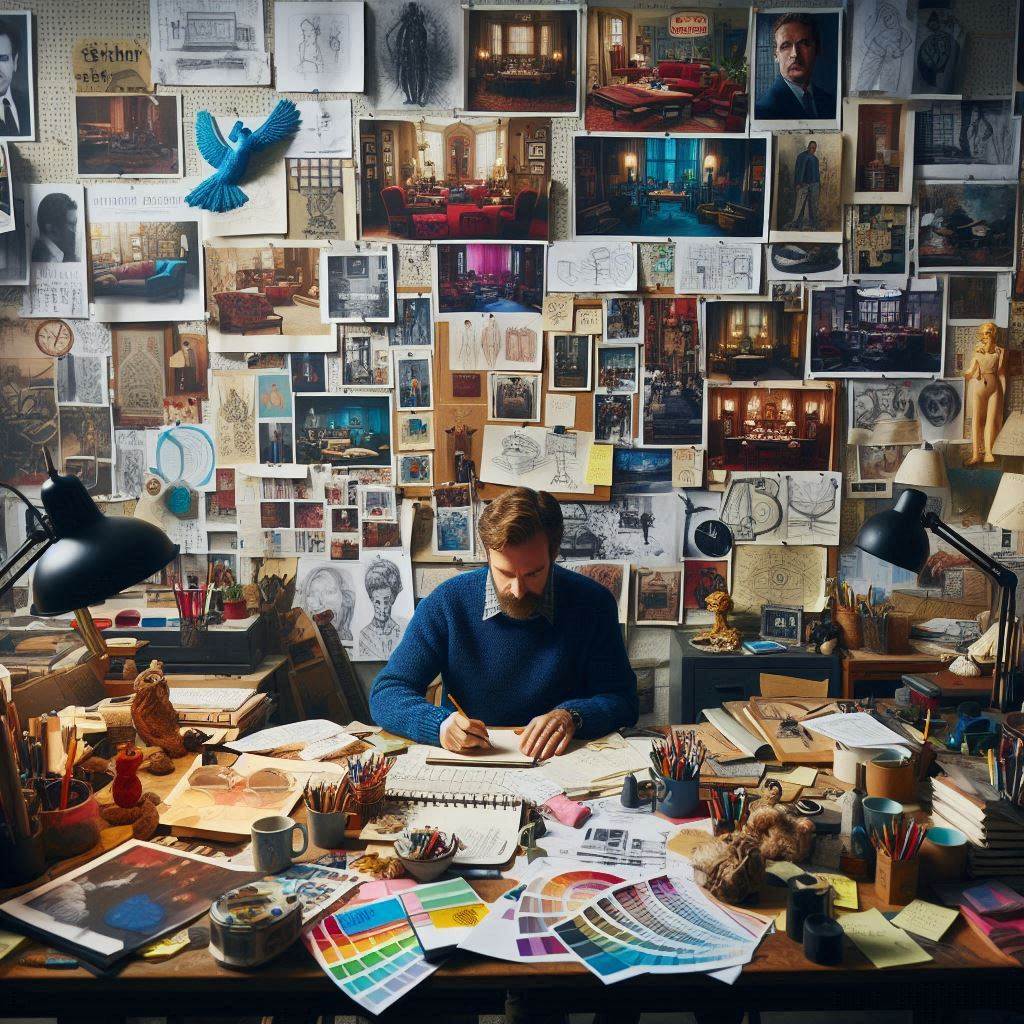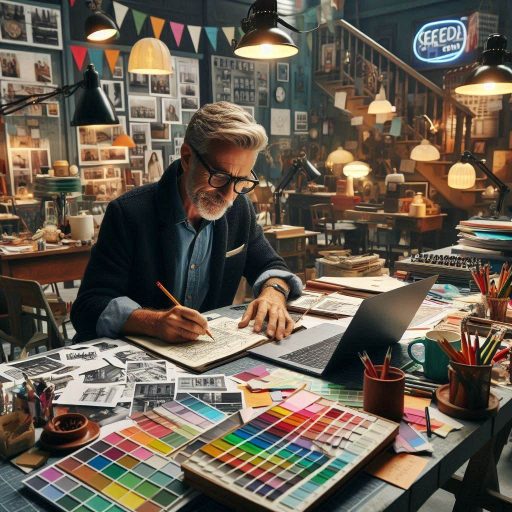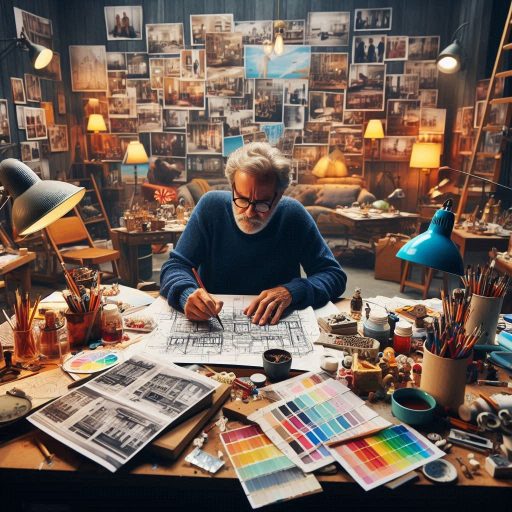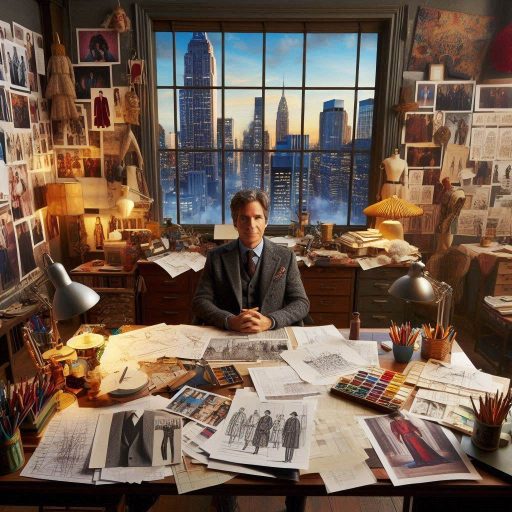Introduction
Production design plays a vital role in the entertainment industry.
It involves creating the visual environments that enhance storytelling in film, television, and theater.
A well-executed design captivates audiences, immersing them in the narrative.
Without strong production design, many projects would struggle to convey their intended emotional impact.
For aspiring production designers, having a strong portfolio is crucial.
A well-crafted portfolio showcases your skills, creativity, and unique style.
It serves as your visual resume, demonstrating your ability to translate concepts into tangible designs.
Potential employers and collaborators often use portfolios to assess a designer’s fit for a project.
Your portfolio should include a variety of work, showcasing different styles and projects.
This diversity demonstrates your versatility and adaptability to various genres and themes.
Include sketches, renderings, and photographs of completed sets to highlight your design process.
Consider adding case studies that explain your design decisions and challenges.
This context provides insight into your creative thinking and problem-solving abilities.
Remember to keep your portfolio organized and visually appealing, reflecting your design sensibility.
A strong portfolio is essential for aspiring production designers.
It effectively communicates your skills and passion for creating captivating visual experiences in the entertainment industry.
Showcasing Variety in Projects
Create a Diverse Portfolio That Showcases Your Range and Versatility as a Designer
A strong portfolio is essential for aspiring production designers.
It serves as a visual representation of your skills and creativity.
When creating your portfolio, focus on diversity.
A varied selection of work demonstrates your versatility as a designer.
Include projects that highlight different design elements.
For instance, you might showcase set designs, props, and costumes.
This variety will give potential employers a comprehensive view of your abilities.
Showcasing a range of styles is crucial.
Experiment with contemporary, historical, and fantastical designs.
Each style presents unique challenges, allowing you to showcase your problem-solving skills.
Emphasizing your adaptability is vital in a competitive field like production design.
Additionally, consider including collaborative projects.
Working with other designers or artists shows your ability to communicate and work as a team.
Highlighting your contributions to these projects can demonstrate your collaborative spirit.
Organize your portfolio to guide viewers through your work.
Start with your strongest pieces to create a memorable first impression.
Use clear and concise captions to explain each project.
Describe your role and the design elements you contributed.
Include Projects from Different Genres, Time Periods, and Styles to Demonstrate Your Creative Abilities
When assembling your portfolio, diversify your projects by genre.
Include examples from film, television, theater, and even commercials.
Each medium has distinct requirements and challenges.
Showcasing work across various genres will highlight your adaptability.
Time periods also play a crucial role in demonstrating your design skills.
Include projects that reflect different historical contexts.
Researching specific eras allows you to create accurate and compelling designs.
This knowledge showcases your dedication to authenticity in your work.
Explore various styles within your projects.
For example, you might include a whimsical children‘s film and a gritty historical drama.
These contrasting styles demonstrate your ability to switch gears and adapt your vision.
Potential employers appreciate designers who can handle diverse creative demands.
Consider creating mood boards or concept sketches for each project.
These elements provide insight into your design process and inspiration.
They also help convey your thought process, showcasing your creativity beyond the final product.
Incorporate photographs of completed sets or designs.
High-quality images allow viewers to appreciate your work in detail.
Make sure to showcase your projects in their best light.
Proper lighting and composition in your photographs can enhance your portfolio’s overall impact.
As you compile your portfolio, continuously seek feedback from peers and mentors.
Constructive criticism can help you identify areas for improvement.
Embrace this feedback and make necessary adjustments to enhance your portfolio.
Lastly, update your portfolio regularly.
As you complete new projects, include them to keep your work current.
A fresh portfolio reflects your growth as a designer and your ongoing dedication to the craft.
Creating a diverse portfolio is essential for aspiring production designers.
Showcase your range and versatility by including projects from various genres, time periods, and styles.
Highlighting collaborative work, mood boards, and high-quality photographs will enhance your presentation.
Read: Top Skills Needed for a Successful Character Designer
Highlighting Technical Skills
Feature Projects That Highlight Your Technical Skills
Creating a strong portfolio is essential for aspiring production designers.
It should prominently feature projects that showcase your technical skills.
Focus on set construction, drafting, and model-making to demonstrate your expertise.
These skills are vital in the production design field and attract potential employers.
When including set construction projects, highlight your involvement in the entire process.
Showcase your ability to work with various materials, tools, and techniques.
Include images of completed sets that reflect your design sensibilities and technical proficiency.
If possible, show the evolution of the project from initial sketches to the final construction.
Drafting skills are also crucial in production design.
Feature examples of technical drawings or blueprints that you created.
This demonstrates your understanding of spatial relationships and construction methods.
Ensure that these drafts are clear, precise, and visually appealing.
Include annotations to explain design decisions and showcase your thought process.
Model-making is another vital skill to highlight.
Include photos of scale models or maquettes you created for projects.
Models help visualize design concepts and communicate ideas effectively.
Provide context for each model, explaining its purpose and the techniques used to create it.
Additionally, consider including a variety of projects in your portfolio.
Diversity in your work showcases your versatility and adaptability as a designer.
Feature different genres and styles, demonstrating your ability to tackle various design challenges.
Detailed Explanations or Behind-the-Scenes Photos
Including detailed explanations of your projects enhances your portfolio significantly.
Each project should have a written description outlining your role and contributions.
Explain the design process and the challenges you faced.
This helps potential employers understand your problem-solving skills and creative thinking.
Behind-the-scenes photos are valuable additions to your portfolio.
They offer insights into your design process and working methods.
Show images of you collaborating with the team, sketching ideas, or constructing sets.
These candid moments reveal your passion and dedication to the craft.
Consider creating a project breakdown for complex designs.
Outline the steps taken from concept to completion.
Include sketches, mood boards, and reference images that inspired your work.
This level of detail showcases your thorough approach and design thinking.
When featuring projects, focus on quality over quantity.
It‘s better to have a few exceptional pieces than many mediocre ones.
Curate your portfolio to highlight your best work, ensuring that it aligns with your career goals.
Additionally, tailor your portfolio to the type of production design work you seek.
Research potential employers to understand their style and requirements.
This allows you to present work that resonates with their vision and needs.
Lastly, keep your portfolio updated regularly.
As you gain more experience and complete new projects, refresh your portfolio to reflect your growth.
An updated portfolio demonstrates your commitment to continuous improvement and professional development.
Aspiring production designers should create portfolios that feature their technical skills.
Highlight set construction, drafting, and model-making projects to showcase expertise.
Provide detailed explanations and behind-the-scenes photos to offer insights into your design process.
By curating a strong portfolio, you position yourself as a compelling candidate in the competitive field of production design.
Read: Career Paths in Ceramic Art and Design
Including Concept Art and Mood Boards
Present Concept Art and Mood Boards That Illustrate Your Design Process and Vision for Each Project
Creating a strong portfolio is essential for aspiring production designers.
Concept art and mood boards play a vital role in showcasing your design vision.
Presenting these elements effectively can make your portfolio stand out.
Start by developing concept art for each project.
Concept art should reflect your design ideas, including characters, settings, and key visuals.
This artwork serves as a visual representation of your creative process.
When creating concept art, focus on clarity and detail.
Use color, texture, and composition to convey your vision.
This attention to detail demonstrates your artistic abilities and thought process.
Next, create mood boards that complement your concept art.
Mood boards compile images, textures, and color palettes that inspire your design.
They provide context for your creative choices and establish the emotional tone of the project.
Incorporate a variety of elements in your mood boards.
Include photographs, illustrations, fabrics, and color swatches that resonate with your vision.
This diversity showcases your ability to gather and synthesize different influences.
Make sure to organize your portfolio cohesively.
Group concept art and mood boards by project to demonstrate your versatility.
Each section should highlight your unique approach to design.
Additionally, consider including sketches and drafts that show your iterative process.
Displaying various stages of development can illustrate your ability to adapt and refine your ideas.
This transparency can resonate with potential employers and collaborators.
How Your Concept Art and Mood Boards Contribute to the Overall Storytelling and Visual Aesthetic of a Production
Concept art and mood boards are crucial for storytelling in production design.
They help communicate the visual narrative and establish the project’s aesthetic.
Each piece of art or imagery contributes to a cohesive vision.
Concept art provides insights into the world you are creating.
It helps directors and producers understand your interpretation of the story.
This clarity can foster collaboration and ensure everyone shares a unified vision.
Mood boards enhance the emotional resonance of your design.
They visually convey the atmosphere and tone of the production.
By showcasing colors and textures, mood boards help set expectations for the overall look.
Additionally, concept art and mood boards guide other departments, such as costumes and cinematography.
They serve as reference points for actors, camera operators, and crew members.
This alignment ensures that all elements of production work harmoniously.
Incorporating visual storytelling in your portfolio can make a significant impact.
Highlight how your designs enhance character development and plot progression.
Show how colors and textures reflect themes and emotions.
Consider including annotations or explanations alongside your artwork.
Brief descriptions can provide context and deepen understanding.
This information can reveal your thought process and how your designs connect to the narrative.
Ultimately, strong concept art and mood boards showcase your ability to envision a complete world.
They illustrate your understanding of how design impacts storytelling.
By effectively presenting these elements, you demonstrate your skills as a production designer.
A compelling portfolio for aspiring production designers should include concept art and mood boards.
These elements illustrate your design process and vision for each project.
They contribute significantly to the overall storytelling and visual aesthetic of a production.
Focus on clarity, diversity, and organization in your presentation.
Read: Freelance Character Design: How to Get Started

Collaborating with Other Creatives
Emphasize Collaborative Work
A strong portfolio showcases your ability to collaborate effectively.
Production design is inherently a team effort.
Highlight projects where you worked alongside directors, cinematographers, costume designers, and other creatives.
This focus demonstrates your skills in collaboration and communication.
Begin by selecting key projects that illustrate your teamwork.
Choose examples that involve diverse roles and responsibilities.
For instance, include a film where you collaborated closely with a director to establish the visual style.
Show how you translated the director‘s vision into tangible designs.
Include projects that highlight your work with cinematographers.
Discuss how you collaborated on lighting and camera angles to enhance set designs.
This collaboration ensures that the production design aligns with the overall visual narrative.
Additionally, showcase any work with costume designers.
Demonstrating how you coordinated with them to create cohesive visuals adds depth to your portfolio.
A successful collaboration between production design and costume design enriches storytelling and visual appeal.
When presenting your work, provide context for each project.
Explain your role, the challenges faced, and how you contributed to the team.
This narrative adds depth and helps potential employers understand your collaborative mindset.
Incorporate Testimonials and References
Including testimonials or references from collaborators strengthens your portfolio.
Positive feedback validates your teamwork skills and professionalism.
Ask former collaborators to write brief testimonials about your contributions.
These endorsements enhance your credibility and showcase your strengths.
Select collaborators who can speak to different aspects of your work.
Directors can discuss your creative input and ability to realize their vision.
Cinematographers can highlight how well you understand spatial relationships and lighting.
When including testimonials, keep them concise and focused.
A few impactful sentences can make a significant difference.
Ensure each testimonial reflects specific qualities that set you apart as a production designer.
In addition to testimonials, consider including contact information for references.
Potential employers may wish to follow up with collaborators for more insights.
Ensure that you have permission from your references before including their contact details.
Create a Cohesive Presentation
Your portfolio should be cohesive and visually appealing.
Organize your projects in a logical order, allowing viewers to easily navigate your work.
Use a consistent layout and design throughout the portfolio.
This consistency reflects your attention to detail and professionalism.
Include high-quality images of your projects.
Show before-and-after shots to illustrate your design process.
Capture the essence of each project by including various angles and perspectives.
Consider adding brief descriptions for each project.
Explain your design choices and how they contributed to the overall production.
This context helps potential employers understand your creative process.
Digital portfolios can include video clips or interactive elements.
Consider showcasing behind-the-scenes footage that highlights your teamwork.
This multimedia approach adds dynamism to your presentation and engages viewers.
In fact, a strong portfolio for aspiring production designers must emphasize collaborative work.
Showcase projects where you worked with directors, cinematographers, and costume designers.
Include testimonials and references to validate your teamwork skills and professionalism.
Ensure your portfolio is cohesive, visually appealing, and well-organized.
By presenting your collaborative efforts effectively, you increase your chances of impressing potential employers.
Your ability to work as part of a team is essential in the production design industry.
A well-crafted portfolio demonstrates your commitment to collaboration and your readiness for a successful career in production design.
Read: Career Paths: Becoming a Professional Character Designer
Demonstrating Problem-Solving Skills
Feature Projects That Overcame Design Challenges
In any production design career, facing challenges is inevitable.
Including projects where you overcame design obstacles can strengthen your portfolio.
Prospective employers value designers who can think creatively under pressure.
Showcasing these experiences proves your adaptability and problem-solving skills.
Feature projects where budget or time constraints required innovative solutions.
Highlight scenarios where materials were limited, but you still achieved your creative vision.
This demonstrates your ability to deliver results in real-world conditions.
Emphasize how you adapted to these limitations without compromising the quality of your design.
For example, if you worked on a project with a tight budget, explain how you found alternative materials or repurposed existing elements.
If you faced time limitations, showcase how you streamlined your process without sacrificing detail.
These experiences show potential employers that you‘re resourceful and able to meet production demands.
Another design challenge worth showcasing is dealing with space limitations.
Whether you worked on a small set or had restricted locations, feature how you optimized the space.
Discuss how you creatively utilized every inch of the set to bring your design to life.
This not only highlights your spatial awareness but also your ability to create visually impactful designs in any environment.
By including these types of projects, you prove your ability to overcome obstacles while maintaining a high standard of design.
These examples will set you apart from other candidates who only showcase straightforward projects.
Explain Your Problem-Solving Process
In your portfolio, don‘t just show the final product‘explain the journey.
Walk potential employers through your problem-solving process.
Detailing how you tackled challenges gives them insight into your thought process.
This shows that you are not only creative but also methodical in your approach.
Start by outlining the challenge you faced.
Was it a budgetary limitation, a tight deadline, or a difficult location? Clearly state the problem to provide context for your solution.
This helps potential employers understand the scope of the issue and why your approach was necessary.
Next, describe the steps you took to solve the problem.
Did you collaborate with other departments, research cost-effective materials, or rework the design to fit the constraints?
Break down your approach to show that your problem-solving wasn‘t accidental but intentional and strategic.
Explain any research or brainstorming techniques you employed.
For example, you might have explored alternative building materials that aligned with the aesthetic but cost less.
Or, perhaps you collaborated with other designers to come up with unconventional solutions.
Highlighting these efforts demonstrates your ability to think outside the box and work collaboratively.
After presenting your solution, show how it ultimately enhanced the final production design.
Explain how overcoming these challenges made your work stronger.
For instance, using a cheaper material might have added a unique texture that elevated the visual storytelling.
Or, your time-saving techniques might have allowed you to focus more on other important design details.
Ultimately, this approach emphasizes how solving problems doesn‘t just fix issues‘it enhances creativity.
Showcasing your problem-solving abilities signals to employers that you can handle real-world challenges with ease.
By featuring these projects and processes, you demonstrate that you can bring value to any production team, regardless of the obstacles you face.
Incorporating Before-and-After Visuals
Showcase Before-and-After Visuals to Highlight Design Transformations
When building your portfolio as an aspiring production designer, including before-and-after visuals is essential.
These visuals offer a powerful way to showcase your ability to transform spaces.
By presenting a side-by-side comparison, you allow potential employers to see your creative process at work.
Before-and-after visuals give clarity to the impact of your design.
The “before” image sets the stage by displaying a raw, untouched space.
The “after” image shows how you‘ve enhanced the space through your design choices.
This direct comparison highlights your skill in turning an ordinary location into a visually compelling set.
To create effective before-and-after images, document your work from start to finish.
Take clear, high-quality photos of each space before you begin designing.
As you make progress, capture key moments that illustrate the transformation.
These images will serve as a visual timeline of your design journey.
Including multiple examples of this process will strengthen your portfolio.
Each project you showcase adds to the narrative of your creative abilities.
Demonstrating a variety of transformations will emphasize your versatility and adaptability as a designer.
Make sure your before-and-after visuals reflect different styles and genres.
When presenting these visuals in your portfolio, organize them in a way that‘s easy to follow.
Label each set of images to clarify the timeline of the transformation.
This organization helps potential employers understand the thought process behind your work.
Provide Insights into Your Design Choices
Including before-and-after visuals is only one part of the equation.
To further enhance your portfolio, provide detailed insights into your design choices.
Explain why you made specific decisions and how they improved the overall production.
This commentary gives potential employers a glimpse into your thought process and creativity.
For each project in your portfolio, discuss your approach to the design.
Explain how you interpreted the director‘s vision or the script‘s requirements.
Highlight the challenges you faced during the design process and how you overcame them.
These insights demonstrate your problem-solving abilities and adaptability.
For example, if you chose a specific color palette, explain why.
Discuss how the colors helped set the mood or tone for the scene.
If you adjusted the layout of a space, describe how those changes affected the actors’ movement and the camera’s perspective.
These details show that your design choices were intentional and thoughtful.
By providing this context, you allow potential employers to see the depth of your work.
They‘ll understand that your designs go beyond aesthetics; they serve the story and enhance the overall production.
This level of insight can set you apart from other candidates who only present visuals without explanation.
Elevate Your Portfolio with Informed Design Decisions
A great production design portfolio combines visual examples and detailed explanations of your creative process.
By including before-and-after visuals, you demonstrate your ability to transform spaces.
These comparisons are powerful evidence of your design skills in action.
Additionally, by providing insights into your design choices, you show that your decisions are thoughtful and intentional.
Explain how your designs contributed to the production‘s success, whether through enhancing the mood, improving functionality, or solving logistical challenges.
Incorporating both elements‘visuals and commentary‘will give your portfolio depth and character.
It not only highlights your technical abilities but also showcases your creativity, storytelling, and problem-solving skills.
Ultimately, this well-rounded approach will help you stand out as an aspiring production designer ready to bring ideas to life.
You Might Also Like: How to Become a Successful Lighting Designer
Transform Your Career Today
Unlock a personalized career strategy that drives real results. Get tailored advice and a roadmap designed just for you.
Start NowConclusion
A strong portfolio is essential for aspiring production designers.
It showcases your skills, creativity, and unique style to potential employers.
A well-curated portfolio demonstrates your ability to visualize and execute design concepts effectively.
Including a variety of projects highlights your versatility.
Feature designs from different genres, such as film, television, or theater.
This diversity showcases your adaptability and broadens your appeal to potential clients or employers.
Quality over quantity matters when building your portfolio.
Select your best work that reflects your strengths and personal aesthetic.
High-quality images and detailed descriptions enhance each project‘s impact.
Continuously updating and refining your portfolio is crucial.
The entertainment industry evolves rapidly, so your portfolio should reflect current trends and techniques.
Regularly revisit older projects to assess their relevance and quality.
Seek feedback from peers and mentors to improve your work.
Constructive criticism can help you identify areas for growth and development.
Remember to tailor your portfolio for specific opportunities.
Highlight relevant projects that align with the job you‘re applying for.
Invest time in your portfolio to stay competitive in the industry.
A polished and engaging portfolio can open doors to exciting opportunities.
Embrace the process, and let your creativity shine through!
[E-Books for Sale]
The Big Book of 500 High-Paying Jobs in America: Unlock Your Earning Potential
$19.99 • 500 High-Paying Jobs • 330 pages
Explore 500 high-paying jobs in America and learn how to boost your career, earn more, and achieve success!
See All 500 High-Paying Jobs of this E-Book
1001 Professions Without a Degree: High-Paying American Jobs You Can Start Now
$19.99 • 1001 Professions Without a Degree • 174 pages
Discover 1001 high-paying jobs without a degree! Unlock career tips, skills, and success strategies for just $19.99!




